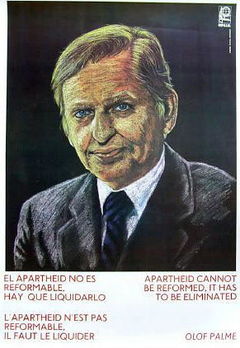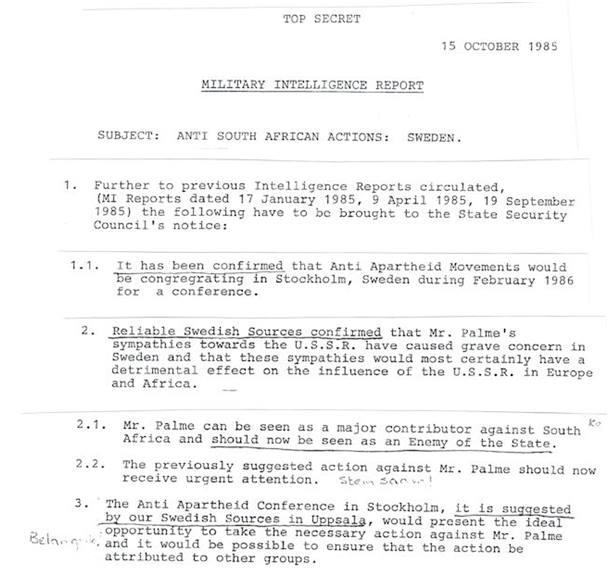Document:Olof Palme — South African Spies Likely Murdered Sweden Prime Minister
| Top Secret Apartheid Intelligence Report says that Olof Palme must “now be seen as an enemy of the State” |
Subjects: Olof Palme, Olof Palme/Assassination, Neels van Tonder, Craig Williamson
Source: Intel Today (Link)
★ Join the Discussion about this document
The murder of Prime Minister Olof Palme on 28 February 1986 shocked Sweden and had a great impact across Scandinavia. A local convict and addict Christer Pettersson was originally convicted of the murder but was acquitted on appeal. The crime remains unsolved to this day. Now, a document from SADF Military Intelligence clearly indicates that the Apartheid regime’s spooks are almost certainly the culprits of this odious assassination.
On 28 February 1986, just before midnight, Olof Palme was walking home from a cinema with his wife Lisbeth Palme in the central Stockholm street Sveavägen when he was shot in the back at close range. A second shot grazed Lisbet’s back. The Prime Minister was pronounced dead on arrival at Sabbatsbergs Sjukhus hospital.
A South Africa Military Intelligence Report — dated 15 October 1985 — appears to solve this three-decade old cold case.
The report concludes that Mr Palme must “now be seen as an enemy of the State”.
South African spies in Sweden are aware that an “Anti Apartheid Conference” will be held in Sweden in February 1986.
The report recommends that “the previously suggested action against Mr Palme should now receive urgent attention.”
Finally, the report concludes that:
“The Anti Apartheid Conference in Stockholm, it is suggested by our Swedish Sources in Uppsala, would present the ideal opportunity to take the necessary action against Mr Palme and it would be possible to ensure that the action be attributed to other groups.”
Following the death of Prime Minister Olof Palme, the CIA wrote a document — dated 6 March 1986 — which summarised his “Foreign Policy Positions“.[1]
Regarding the Swedish-Soviet relations, the CIA wrote:
- “Palme believed his official visit to Moscow scheduled for April 1986 would significantly enhance the Swedish-Soviet dialog.”
The Document
Update 2 April 2018
Several readers have raised questions regarding the authenticity of the SA Military Intelligence document. Others wonder why Palme was ‘suddenly’ branded an “Enemy of the State” in late 1985? Finally, one wonders why the Main Stream Media — even in Sweden — have not investigated and reported this amazing breakthrough?
Authenticity — There is absolutely no doubt that this document is genuine. Intel Today received this document from Swedish journalist Anders Leopold.
Leopold obtained this document — and a few others — from Deborah Matthews, archival coordinator at the South African History Archive (SAHA), Johannesburg, South Africa.
These documents were donated by the South African journalist and author De Wit Potgieter, who found some them among the remains of the South Africa Military Intelligence Service (MI) archive.
A large part of this secret documents archive was unfortunately destroyed in 1994 when the apartheid regime broke down. Many files are therefore missing and/or incomplete.
"Enemy of the State" — One needs to look back at the historical context to understand why Palme — and his government — was indeed a “clear and present danger” to the survival of the apartheid regime.
By 1986, the Anti-Apartheid Movement was at its strongest in Europe. There was a permanent (24/7) demonstration outside South Africa House in London. Many companies had been persuaded to disinvest from South Africa. meanwhile, South Africa’s “slave states” of Mozambique, Angola, Namibia and others were seeing a rise in resistance movements with world-wide support.
One of those prominent anti-apartheid supporters was — of course — Olof Palme. He was strongly opposed to apartheid and the SA government at a time when Margaret Thatcher and Ronald Reagan strongly supported them.
Sweden had also welcomed many US draft-dodgers and escapees from the Vietnam war and the Swedish government strongly opposed US aggression in Central America. [Indeed, a young fellow by the name of Bill Clinton attempted to obtain Swedish citizenship!] Some investigators have suggested that Palme was about to blow the whistle on the Iran-Contra scandal.
At that time, many idealistic liberals in Europe saw Sweden under Palme as a haven against Thatcherite and Reaganite aggressive capitalism and military interventions in poor countries. It was no secret that Thatcher and Reagan hated Palme.
According to Anders Leopold’s own analysis, there was no ‘special trigger’ in 1985 that precipitate the decision to assassinate Palme:
- “It was nevertheless a time when Palme was leading the boycott against South Africa and got the whole world with him,” Leopold told Intel Today.
- “In the Nordic program, importers and exporters were recommended to seek out new markets and prevent procurement of South African products.
In Sweden, a ban was imposed on imports of agricultural products from South Africa, largely prohibiting imports of consumer goods from South Africa. P.W. Botha was furious.
So when signals came from the United States that they wanted to remove Palme — fearing that he, as a peace maker in the Iran-Iraq war was about to expose the United States illegal arms trade with Iran — the South Africa’s military security service was commissioned to stop him.”
Main Stream Media — It is hard to understand why the Main Stream Media ignore such an important story. I asked Swedish author and journalist Sixten Svensson why the story is downplayed even in Palme’s country? His answer was as simple as it is sad:

